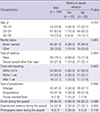1. Classen CC, Palesh OG, Aggarwal R. Sexual revictimization: a review of the empirical literature. Trauma Violence Abuse. 2005; 6:103–129.
2. Korean Women's Development Institute. The Sexual Violence Survey in 2013. Seoul: Ministry of Gender Equality and Family;2013.
3. Walsh K, Danielson CK, McCauley JL, Saunders BE, Kilpatrick DG, Resnick HS. National prevalence of posttraumatic stress disorder among sexually revictimized adolescent, college, and adult household-residing women. Arch Gen Psychiatry. 2012; 69:935–942.
4. Lau M, Kristensen E. Sexual revictimization in a clinical sample of women reporting childhood sexual abuse. Nord J Psychiatry. 2010; 64:4–10.
5. Miner MH, Flitter JM, Robinson BB. Association of sexual revictimization with sexuality and psychological function. J Interpers Violence. 2006; 21:503–524.
6. Messman-Moore TL, Long PJ. The role of childhood sexual abuse sequelae in the sexual revictimization of women: an empirical review and theoretical reformulation. Clin Psychol Rev. 2003; 23:537–571.
7. Bockers E, Roepke S, Michael L, Renneberg B, Knaevelsrud C. Risk recognition, attachment anxiety, self-efficacy, and state dissociation predict revictimization. PLoS One. 2014; 9:e108206.
8. Kearns MC, Calhoun KS. Sexual revictimization and interpersonal effectiveness. Violence Vict. 2010; 25:504–517.
9. Arata CM. From child victim to adult victim: a model for predicting sexual revictimization. Child Maltreat. 2000; 5:28–38.
10. Gidycz CA, Coble CN, Latham L, Layman MJ. Sexual assault experience in adulthood and prior victimization experiences. Psychol Women Q. 1993; 17:151–168.
11. Dunmore E, Clark DM, Ehlers A. A prospective investigation of the role of cognitive factors in persistent posttraumatic stress disorder (PTSD) after physical or sexual assault. Behav Res Ther. 2001; 39:1063–1084.
12. Resick PA, Schnicke M. Cognitive Processing Therapy for Rape Victims: a Treatment Manual (Vol. 4). Thousand Oaks, CA: Sage;1993.
13. Foa EB, Riggs DS. Post-traumatic stress disorder in rape victims. In : Oldham JM, Riba MB, Tasman A, editors. American Psychiatric Press Review of Psychiatry, Volume 12. Washington, D.C.: American Psychiatric Press;1993. p. 272–303.
14. Foa EB, Rothbaum BO. Treating the Trauma of Rape: Cognitive-behavioral Therapy for PTSD. New York, NY: Guilford;2001.
15. Shin KM, Chang HY, Cho SM, Kim NH, Kim KA, Chung YK. Avoidance symptoms and delayed verbal memory are associated with post-traumatic stress symptoms in female victims of sexual violence. J Affect Disord. 2015; 184:145–148.
16. Shin KM, Cho SM, Lee SH, Chung YK. A pilot prospective study of the relationship among cognitive factors, shame, and guilt proneness on posttraumatic stress disorder symptoms in female victims of sexual violence. J Korean Med Sci. 2014; 29:831–836.
17. Foa EB, Ehlers A, Clark DM, Tolin DF, Orsillo SM. The Posttraumatic Cognitions Inventory (PTCI): development and validation. Psychol Assess. 1999; 11:303–314.
18. Foa EB, Riggs DS, Dancu CV, Rothbaum BO. Reliability and validity of a brief instrument for assessing post-traumatic stress disorder. J Trauma Stress. 1993; 6:459–473.
19. Han OS, Hong JP. Korean Version of the Structured Clinical Interview for DSM-IV. Seoul: Hana Medical Publishing Company;2000.
20. Korea Psychology. Manual for the K-BDI-II. Daegu: Korea Psychology;2014.
21. Korea Psychology. Manual for the K-BAI. Daegu: Korea Psychology;2014.
22. Lee YS, Song JY. A Study of reliability and validity of the BDI, SDS, and the MMPI-D scales. Korean J Clin Psychol. 1991; 10:98–113.
23. Han EK, Cho YR, Park SH, Kim HR, Kim SH. Factor structure of the Korean version of the Beck Anxiety Inventory: an application of confirmatory factor analysis in psychiatric patients. Korean J Clin Psychol. 2003; 22:261–270.
24. Morina N, Wicherts JM, Lobbrecht J, Priebe S. Remission from post-traumatic stress disorder in adults: a systematic review and meta-analysis of long term outcome studies. Clin Psychol Rev. 2014; 34:249–255.
25. Filipas HH, Ullman SE. Child sexual abuse, coping responses, self-blame, posttraumatic stress disorder, and adult sexual revictimization. J Interpers Violence. 2006; 21:652–672.
26. Messman-Moore TL, Brown AL. Risk perception, rape, and sexual revictimization: a prospective study of college women. Psychol Women Q. 2006; 30:159–172.
27. Koo KH, Stephens KA, Lindgren KP, George WH. Misogyny, acculturation, and ethnic identity: relation to rape-supportive attitudes in Asian American college men. Arch Sex Behav. 2012; 41:1005–1014.
28. Mills CS, Granoff BJ. Date and acquaintance rape among a sample of college students. Soc Work. 1992; 37:504–509.
29. Koo KH, Nguyen HV, Gilmore AK, Blayney JA, Kaysen DL. Posttraumatic cognitions, somatization, and PTSD severity among Asian American and White college women with sexual trauma histories. Psychol Trauma. 2014; 6:337–344.
30. Cloitre M. The “one size fits all” approach to trauma treatment: should we be satisfied? Eur J Psychotraumatol. 2015; 6:27344.
31. Konanur S, Muller RT, Cinamon JS, Thornback K, Zorzella KP. Effectiveness of trauma-focused cognitive behavioral therapy in a community-based program. Child Abuse Negl. 2015; 50:159–170.
32. Kim S, Noh D, Kim H. A Summary of selective experimental research on psychosocial interventions for sexually abused children. J Child Sex Abuse. 2016; 25:597–617.
33. DePrince AP, Chu AT, Labus J, Shirk SR, Potter C. Testing two approaches to revictimization prevention among adolescent girls in the child welfare system. J Adolesc Health. 2015; 56:S33–S39.
34. Hill JM, Vernig PM, Lee JK, Brown C, Orsillo SM. The development of a brief acceptance and mindfulness-based program aimed at reducing sexual revictimization among college women with a history of childhood sexual abuse. J Clin Psychol. 2011; 67:969–980.
35. Valenstein-Mah H, Larimer M, Zoellner L, Kaysen D. Blackout drinking predicts sexual revictimization in a college sample of binge-drinking women. J Trauma Stress. 2015; 28:484–488.
36. Walsh K, Resnick HS, Danielson CK, McCauley JL, Saunders BE, Kilpatrick DG. Patterns of drug and alcohol use associated with lifetime sexual revictimization and current posttraumatic stress disorder among three national samples of adolescent, college, and household-residing women. Addict Behav. 2014; 39:684–689.
37. Gilmore AK, Lewis MA, George WH. A randomized controlled trial targeting alcohol use and sexual assault risk among college women at high risk for victimization. Behav Res Ther. 2015; 74:38–49.








 PDF
PDF ePub
ePub Citation
Citation Print
Print



 XML Download
XML Download